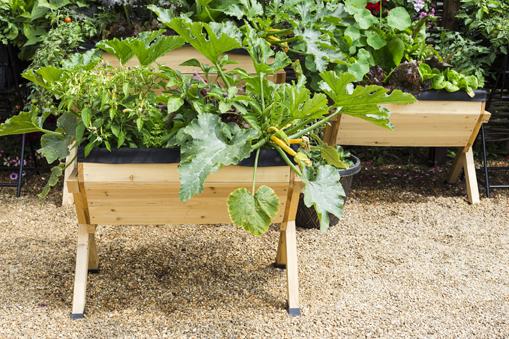Good Things Come In Small Packages
By Dawn Williams, Senior News Associate Publisher

While spring approaches each year, Jeff and I can be found in the gardening section of our local home improvement stores, perusing the flower and vegetable seed packets as if they were bargain priced gold bricks. Gardening is a passion we’ve shared for as long as we’ve been together, each year tearing up more lawn so we can add yet another garden, spending more on seedlings than we would by simply buying produce at the grocery store, and investing entire weekends hauling, tilling, digging, and planting. It’s been a labor of love for both of us.
But things have changed in the last few years. In our late 50s, we find it takes days to recover from our weekend warrior adventures. The weeds have been gaining strength, and our current job responsibilities limit the time we have available to deal with them. And perhaps the deciding factor was the discovery of problem with our carefully composted but never chemically treated soil. Much of our crops have succumbed to early blight, greatly reducing the yield and killing the affected plants before the growing season has ended. The non-checmical treatment is to cover the soil with thick clear plastic all summer, creating higher ground temperatures that supposedly kill the fungus that causes the disease.
I never thought I’d say this, but we’ve decided to downsize this year.
Many boomers and seniors eventually decide to cut back on their gardening requirements to accommodate their capabilities, and perhaps for a number of other reasons as well. For us, this isn’t a permanent decision, and we’ve come up with ways to enjoy our favorite summer hobby in a limited way, at least for this season. If you’re also considering a downsize, here are some ideas we’ve come up with to reduce the work while still keeping our hands in the dirt.
Take advantage of containers. Most crops can be grown easily in containers. We’ve found that five-gallon buckets available at home improvement stores make excellent containers for most crops we choose to grow. At about $3 each, they’re very affordable, even considering the cost of soil to fill them.
We drill holes in the bottoms of each bucket. To improve drainage, we crumble the thin plastic containers seedlings come in to create a single layer of air pockets. You can also use small rocks, but this method makes the containers much heavier.
Be sure to provide each plant with the same support you would give it in the garden. Pole beans, peas, cucumbers, and other climbing crops need a trellis. Tomatoes need a cage. You can opt to purchase hybrid seedlings that have been modified specifically to grow in containers. These are sometimes referred to as patio plants.
Buy or make your own soil mix that is appropriate for container gardens. In addition to soil, your mix should include organic matter like peat moss and compost, as well as perlite or vermiculite to keep the soil aerated. Use an appropriate fertilizer according to package directions, or add compost around the base of the plant as needed.
Focus on weed control. Since we are determined to avoid chemicals in our gardens, weed control is a difficult, labor-intensive task. If you plan to avoid herbicides, prevention is the best approach. Apply a 3-inch layer of mulch early in the season. Pull any weeds you see as soon as possible. Doing so on the spot isn’t always practical, but scheduling a day each week to see to the task will keep the weeds from getting out of control. Clip “volunteers” – young tree and bush sprouts that appear where you don’t want them – while they’re still small, and if possible, dig into the soil to remove the young root as well.
Increase the perennial population. We love annuals for the year-long color, and will continue to use them. But over the years, the experienced gardener can create a flower bed in which various perennials are in bloom throughout the season. It’s easier than you think. Make a chart with headings for each part of the season (early spring, mid-spring, late spring, early summer, mid-summer, late summer, early fall and mid-fall). Then research perennials that grow in your zone and bloom during each time of the season. Although we prefer an explosion of color, consider your color scheme if prefer particular color combinations.
And don’t forget winter color! Many ornamental plants, small shrubs, and trees produce blossoms in the spring, then produce berries that persist through the late fall and winter months. Others, such as yuccas, stay green year-round.
Consider raised beds. Although this solution involves an investment of time, money, and effort upfront, raised beds make it much more convenient (and easier on your back and knees) to maintain a garden. Plans for building raised beds are widely available online. Be sure to keep them wide enough to provide the amount of space your intended crops require, but not so wide that you can’t easily reach to the middle of the bed to tend your plants and harvest the crops.
If you’re at a point that your previous gardening habits have become difficult, remember that good things often come in small packages. Scaling back and adapting to your needs allows you to eliminate the problems while still keeping your hands in the dirt and enjoying your favorite passion.